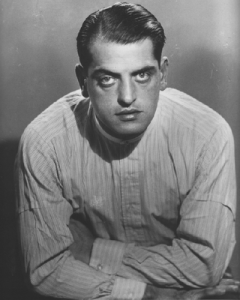Spanish film director Luis Buñuel was born on this date, February 22, 1900 in Calanda, Spain. I’ve been on a mini-obsessive run of Buñuelismo, reading his autobiography and some film criticism, and watching a couple of his films: L’Age d’Or (1930) his second feature, made just as the surrealist movement was gaining wider visibility; and Viridiana (1961), the 23rd movie of his prolific career.
 Buñuel’s debut, Un Chien Andalou (1929) was a short film produced in collaboration with Salvador Dalí. This visually arresting series of disturbing scenes (you can watch it here) had been a surprise success. But his sophomore effort, released the following year, was in theaters just over two months before violent protests led to L’Age d’Or being banned and pulled from distribution for almost 50 years.
Buñuel’s debut, Un Chien Andalou (1929) was a short film produced in collaboration with Salvador Dalí. This visually arresting series of disturbing scenes (you can watch it here) had been a surprise success. But his sophomore effort, released the following year, was in theaters just over two months before violent protests led to L’Age d’Or being banned and pulled from distribution for almost 50 years.
Maybe folks couldn’t handle the more sustained irreverence of L’Age d’Or. Fifteen minutes of surrealist gags could be easily dismissed. An hour-long assault on religion and the social order must have been too much for French reactionary elements like the Patriots League and the Anti-Jewish League. They threw ink across the screen, tossed smoke bombs and firecrackers into the audience, and stormed out of the theater to riot in the streets (pausing to vandalize some paintings in the lobby).
What were they so upset about? Well, you can watch it for yourself. This was one of the first films to use sound. It has some dialog and sound design (more cowbell!) and the music was part of the film, rather than having a record or an orchestra playing alongside the images. But the lines spoken tend toward the non sequitur, and there is nothing particularly shocking in the score or the onscreen racket. Instead, the scenes build in an inexplicable succession of unsettling, emotionally charged expressions. These include: the hero, left eye inexplicably gouged out, crooning “My love, my love,” as blood pours down his face; a pair of lovers devouring each other’s fingers; the heroine lovingly kissing and sucking the toe of a statue; a bishop being thrown out of a window; guests at a party continuing their revelry as peasants roll through on a horse-drawn cart & the kitchen catches fire; a character from de Sade’s 120 Days of Sodom depicted as Christ; bunches of hair (women’s? scalps?) nailed to a cross.
Using images such as these, the film assaults the values of religion, family, honor, fatherland and civility. Buñuel grabs the complacency of his times by the collar and shakes it until the dualities – fantasy/reality, emotion/rationality, beauty/ugliness – blur and comingle. In the process, he attempts to reveal the artificiality, emptiness and futility of “good society” as contrasted with the power of passion, the unconscious, and the irrational.
(contributed by Inti)

